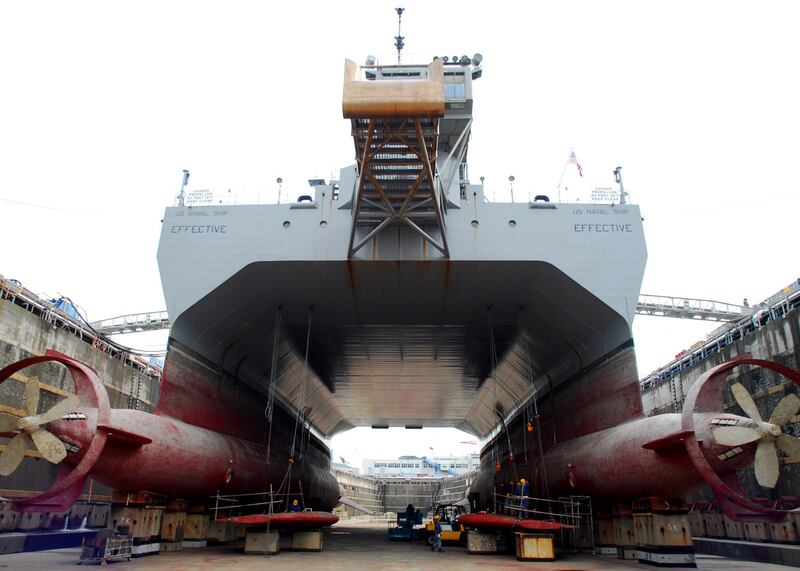China has accused the U.S. of intensifying spying activities in the disputed South China Sea after the U.S. Navy deployed three of its ocean surveillance vessels in the region.
An aircraft carrier, the USS Abraham Lincoln, also entered the South China Sea on Friday, ahead of the large-scale Philippines-U.S. joint military exercise Balikatan 22.
Data provided by the ship-tracking website MarineTraffic show the ocean survey ship USNS Bowditch is currently operating in Vietnam’s exclusive economic zone (EEZ), 60 nautical miles east of Danang and about 90 nautical miles south of China’s Hainan Island.
At the same time, another ocean surveillance vessel, the USNS Effective, is in waters northwest of the Philippines, 250 nautical miles from Scarborough Shoal, which China calls Huangyan Island.
The third ocean surveillance ship, USNS Loyal, is in the sea east of Taiwan.
China's state-run Global Times said they are "spy ships" that carry out reconnaissance in support of anti-submarine warfare against China. They have been in the area since March 17, it said.
“The U.S. Navy has frequently sent spy vessels near China in recent years, but it is unusual to see so many of them present at the same time,” Global Times said.
Amid the raging war in Ukraine, the deployment of the ships may serve as an indication of the U.S. commitment in the Indo-Pacific.

‘Spy ships’
The USNS Bowditch is a Pathfinder-class survey ship that has often been deployed in the South China Sea. The USNS Effective and USNS Loyal are both Victorious-class ocean surveillance ships.
The ships measure water conditions and deploy underwater drones that take very detailed measurements of water temperature, salinity, the acoustic environment and the water’s chemical make-up. They also conduct very detailed surveys of the ocean bottom.
“The ships’ data can be used to detect submarines and identify ships' noises, so from China's perspective they are spy ships,” said Carl Schuster, a retired U.S. Navy captain and former director of operations at the U.S. Pacific Command's Joint Intelligence Center.
“China's survey ships do similar operations so in many ways, China's description of the American ships provides an insight into how China uses its survey ships,” he said.
MarineTraffic also shows that a Chinese survey vessel has just been deployed.
China's homegrown third-generation, spacecraft-tracking ship Yuanwang-5 is currently in waters east of Taiwan, some 255 nautical miles from the island.
It’s unclear where the ship, described by the Chinese military as “a backbone in China's maritime tracking and measuring network,” is heading.
China has four Yuanwang-class tracking ships in active operation, including Yuanwang-5 which entered service in 2007.
Some security analysts, like Paul Buchanan at the Auckland, New Zealand-based 36th Parallel Assessments risk consultancy, say the Yuanwang-class ships are “dual-platform spy ships.”
Buchanan has previously been quoted by the NZ Herald as saying the ships are used for intelligence collection and tracking satellites. He said 60 to 70 per cent of their work is looking for other people's signals and 30 per cent is the satellite work. Buchanan also said the U.S. and China use their signals collection ships partly to track rival submarines.
In another development, the American expeditionary mobile base USS Miguel Keith entered the South China Sea on March 21, the Beijing-based South China Sea Strategic Situation Probing Initiative (SCSPI), a think tank, said.
This is the first time the USS Miguel Keith entered the South China Sea since its deployment to the West Pacific in October 2021, the SCSPI said.
The 90,000-ton ship that can serve as a strategic platform and command center is the second-biggest ship type in the U.S. Navy after aircraft carriers.
It is unclear if the USS Miguel Keith will join the Balikatan 22 joint exercise between the U.S. and Philippine armies taking place from March 28 to April 8 across the Luzon Strait.
With over 5,000 U.S. military personnel and 3,800 Filipino soldiers, the U.S. Embassy in Manila said that Balikatan 22 will be "one of the largest-ever iterations of the Philippine-led annual exercise" which this year coincides with the 75th anniversary of U.S.-Philippine security cooperation.
